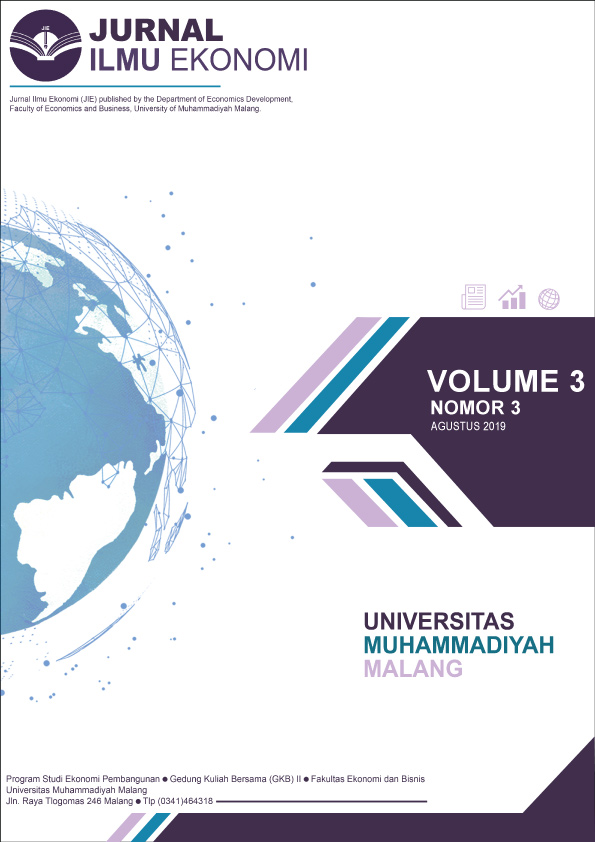PENGARUH PERTUMBUHAN EKONOMI DAN INVESTASI TERHADAP KETIMPANGAN PENDAPATAN DI KABUPETEN/KOTA PROVINSI NUSA TENGGARA BARAT
DOI:
https://doi.org/10.22219/jie.v3i3.8993Keywords:
Income inequality, economy growth, investmentAbstract
The distinction of interzonal potential will cause several problems such as uneven economic growth, the area-centered spreading investment, and income inequality. This research aims to analyze the effect of economic growth and investment on the inter-regional income inequality in West Nusa Tenggara from 2012 to 2017. This research uses secondary data obtained from BPS-Statistics Indonesia (Badan Pusat Statistik), and the Indonesian Investment Coordinating Board (Badan Koordinasi Penanaman Modal – BPKM). Williamson Index is used to representing income inequality, and the method analysis is the panel data analyzing with a Fixed Effect Model (FEM). The effect between a dependent variable and independent variable will be shown that economic growth has a positive and significant influence towards the income inequality, and investment has a positive and not significant influence towards the income inequality.
Downloads
References
Adipuryanti, N. L. Y., & Sudibia, I. K. (2013). Analisis Pengaruh Jumlah Penduduk Yang Bekerja Dan Investasi Terhadap Ketimpangan Distribusi Pendapatan Melalui Pertumbuhan Ekonomi Kabupaten/Kota Di Provinsi Bali. Jurnal Kependudukan Dan Pengembangan Sumber Daya Manusia, XI(1), 20–28. https://doi.org/10.1016/j.actaastro.2014.11.036
Aggina, D., & Artaningtyas, W. D. (2017). Pengaruh Pertumbuhan Ekonomi, Pertumbuhan Penduduk, Pertumbuhan Investasi, dan Indeks Pembangunan Manusia Terhadap Ketimpangan Distribusi Pendapatan di Daerah Istimewa Yogyakarta Tahun 2007-2014. Buleti Ekonomi, 15, 1–154.
Arifin, Z. (2012). Analisis Perbandingan Perekonomian Pada Empat Koridor di Propinsi Jawa Timur. Jurnal Humanity, 5.
Boedirachminarni, A., & Suliswanto, M. S. W. (2017). PENGEMBANGAN EKOWISATA DI KABUPATEN MALANG. Jurnal Ekonomi Pembangunan UMM, 15, 105–116.
BPS Nusa Tenggara Barat. (n.d.). Badan Pusat Statistik Nusa Tenggara Barat. Retrieved from https://ntb.bps.go.id/
Hartini, N. T. (2017). Pengaruh PDRB Perkapita, Investasi dan IPM Terhadap Ketimpangan Pendapatan Antar Daerah Di Provinsi DIY Tahun 2011-2015. Jurnal Pendididkan Dan Ekonomi, 6(6), 530–539. Retrieved from nitatrihartini@gmail.com
Kuncoro, M. (2004). Analisis Spasial san Regiona, Studi Aglomerasi dan Kluster Industri Indonesia (kedua). Yogyakarta: UPP AMP YKPN.
Kusuma, H. (2016). Desentralisasi Fiskal dan Pertumbuhan Ekonomi di Indonesia. Jurnal Ekonomi Kuantitatif Terapan, 9.
Nangarumba, M. (2015). Analisis Pengaruh Struktur Ekonomi , Upah Minimum Provinsi , Belanja Modal , dan Investasi Terhadap Ketimpangan Pendapatan di Seluruh Provinsi di Indonesia Tahun 2005-2014. Jesp, 7(2), 9–26.
Nuraini, I. (2012). Analisis Sumber-Sumber Pertumbuhan Output Regional Kota Malang, 5, 109–115.
Pradnyadewi, D., & Purbadharmaja, I. B. (2017). Pengaruh IPM, Biaya Infrastruktur, Investasi Dan Pertumbuhan Ekonomi Terhadap Ketimpangan Distribusi Pendapatan Di Provinsi Bali. E-Jurnal EP Unud, 6(2), 255–285.
Saputra, N. C. (2016). Analisis pengaruh pertumbuhan ekonomi, pengangguran,dan indeks pembangunan manusia terhadap ketimpangan pendapatan antar kabupaten/kota di Provinsi jawa timur. Malang.
Sukirno, S. (2006). Ekonomi Pembanguanan, Proses, Masalah dan Dasar Kebijakan. Jakarta: Kencana.
Sultan, & Sodik, J. (2010). Analisis Ketimpangan Pendapatan Regional Di DIY-Jawa Tengah Serta Faktor-Faktor Yang Mempengaruhi Periode (2000-2004). Buletin Ekonomi, 8(1), 1–70.
Susilowati, D., Sri, M., & Suliswanto, W. (2015). MANUSIA , UTANG LUAR NEGERI DAN KEMISKINAN ( KAJIAN TEORITIS DI INDONESIA ), 89–106.
Todaro, M. P., & Smith, S. C. (2011). Pembangunan Ekonomi (kesebelas). Jakarta: Erlangga.
Yuliani, T. (2014). Pertumbuhan Ekonomi dan Ketimpangan Pendapatan Antar kabupaten di kalimantan Timur. JEJAK, 8(Journal of Economics and Policy). https://doi.org/http://dx.doi.org/10.15294/jejak.v7i1.
Downloads
Published
How to Cite
Issue
Section
License
Copyright (c) 2019 Jurnal Ilmu EKonomi JIE

This work is licensed under a Creative Commons Attribution-ShareAlike 4.0 International License.
Authors who publish with this journal agree to the following terms:
- For all articles published in the JIE (Jurnal Ilmu Ekonomi), copyright is retained by the authors. Authors give permission to the publisher to announce the work with conditions. When the manuscript is accepted for publication, the authors agree to the automatic transfer of non-exclusive publishing rights to the publisher.
- Authors retain copyright and grant the journal right of first publication with the work simultaneously licensed under a Creative Commons Attribution-NonCommercial-ShareAlike 4.0 International License that allows others to share the work with an acknowledgement of the work's authorship and initial publication in this journal.
- Authors are able to enter into separate, additional contractual arrangements for the non-exclusive distribution of the journal's published version of the work (e.g., post it to an institutional repository or publish it in a book), with an acknowledgement of its initial publication in this journal.
- Authors are permitted and encouraged to post their work online (e.g., in institutional repositories or on their website) prior to and during the submission process, as it can lead to productive exchanges, as well as earlier and greater citation of published work (See The Effect of Open Access).
This is an open access article and licensed under a Creative Commons Attribution-NonCommercial-ShareAlike 4.0 International License








